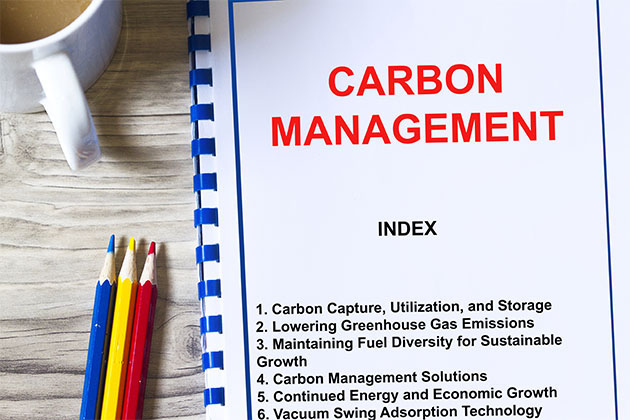ວິທີການຈັບກາກບອນໃໝ່ໄດ້ຖືກວາງອອກເພື່ອຈັບເອົາກາກບອນໄດອອກໄຊຈາກການປ່ອຍອາຍພິດຈາກຟອດຊິວສເລັດ
ການປ່ອຍອາຍພິດເຮືອນແກ້ວແມ່ນຜູ້ປະກອບສ່ວນທີ່ໃຫຍ່ທີ່ສຸດຕໍ່ການປ່ຽນແປງດິນຟ້າອາກາດ. ການປ່ອຍອາຍພິດເຮືອນແກ້ວທີ່ສໍາຄັນແມ່ນຜົນມາຈາກການອຸດສາຫະກໍາຂະຫນາດໃຫຍ່ແລະກິດຈະກໍາຂອງມະນຸດ. ການປ່ອຍອາຍພິດເຮືອນແກ້ວສ່ວນໃຫຍ່ເຫຼົ່ານີ້ແມ່ນຂອງ carbon dioxide (CO2) from burning of fossil fuels. The total concentration of CO2 in the atmosphere has increased by more than 40 percent ever since the era of industrialization started. This steady increase in greenhouse emissions is warming the ດາວ in what is termed as ‘ໂລກຮ້ອນ’ as computer simulations have shown that emissions are responsible for increase in the average surface temperature of earth over time indicating ‘climate change’ due to changes in rainfall patterns, storm severity, sea levels etc. Thus, developing suitable ways of ‘trapping or capturing’carbon dioxidefrom emissions is a critical aspect of tackling climate change. Carbon capture technology has been around for decades but has recently acquired more focus due to environmental concerns.
ວິທີການຈັບຄາບອນໃຫມ່
The standard procedure of ຄາບອນ capture involves trapping and separating CO2 from a gaseous mixture, then transporting it to storage and storing it remotely away from the atmosphere usually underground. This process is highly energy intensive, involves several technical issues, risks and limitations, for example, high probability of leakage at the storage site. A new study published in Chem ອະທິບາຍທາງເລືອກທີ່ດີສໍາລັບການຈັບຄາບອນ. ນັກວິທະຍາສາດຂອງພະແນກພະລັງງານຂອງສະຫະລັດອາເມລິກາໄດ້ພັດທະນາວິທີການທີ່ເປັນເອກະລັກເພື່ອເອົາ CO2 ອອກຈາກໂຮງງານໄຟຟ້າຖ່ານຫີນແລະຂະບວນການນີ້ຕ້ອງການພະລັງງານຫນ້ອຍລົງ 24 ເປີເຊັນເມື່ອປຽບທຽບກັບມາດຕະຖານທີ່ຖືກນໍາໃຊ້ໃນອຸດສາຫະກໍາໃນປະຈຸບັນ.
Researchers worked on naturally occurring ອິນຊີ compounds called bis-iminoguanidines (BIGs) which have the ability to bind to negatively charged anions as seen inprevious studies. They thought that this particular property of BIGs should also be applicable to bicarbonate anions. So BIGs can act like a sorbent (a substance which collects other molecules) and convert CO2 into solid limestone (calcium carbonate). Soda lime is a mixture of calcium and sodium hydroxides used by scuba divers, submarines and other closed breathing environments to filter exhaled air and prevent any dangerous accumulation of CO2. The air can be then recycled multiple times. For example, rebreathers for scuba divers enables them to stay underwater for long time which is otherwise impossible.
ວິທີການທີ່ເປັນເອກະລັກທີ່ຕ້ອງການພະລັງງານຫນ້ອຍ
Based upon this understanding they developed a CO2 separation cycle which used an aqueous BIG solution. In this particular carbon-capture method they passed flue gas through the solution which caused CO2 molecules to bind to BIG sorbent and this binding would crystallize them into a solid type of ອິນຊີ limestone. When these solids were heated to 120 degrees Celsius, bound CO2 would be released which could then be stored. Since this process occurs at relatively lower temperatures compared to existing carbon-capture methods, the energy required for the process is reduced. And, solid sorbent could be be dissolved again in ນ້ໍາ and recycled for reuse.
ເທັກໂນໂລຍີການຈັບຄາບອນໃນປະຈຸບັນມີບັນຫາຫຼາຍຢ່າງເຊັ່ນ: ບັນຫາກ່ຽວກັບການເກັບຮັກສາ, ຄ່າໃຊ້ຈ່າຍພະລັງງານສູງແລະອື່ນໆ. ບັນຫາຕົ້ນຕໍແມ່ນການນໍາໃຊ້ສານລະເຫີຍທີ່ລະເຫີຍຫຼືເສື່ອມໂຊມໃນໄລຍະເວລາແລະຍັງຕ້ອງການຢ່າງຫນ້ອຍ 60 ສ່ວນຮ້ອຍຂອງພະລັງງານທັງຫມົດສໍາລັບການເຮັດຄວາມຮ້ອນໃຫ້ເຂົາເຈົ້າ. ສູງ. ທາດ sorbent ແຂງໃນການສຶກສາໃນປະຈຸບັນໄດ້ເອົາຊະນະຂໍ້ຈໍາກັດດ້ານພະລັງງານເພາະວ່າ CO2 ຖືກຈັບຈາກເກືອ bicarbonate ແຂງ crystallized ເຊິ່ງຕ້ອງການພະລັງງານຫນ້ອຍລົງປະມານ 24 ເປີເຊັນ. ຍັງບໍ່ມີການສູນເສຍ sorbent ເຖິງແມ່ນວ່າຫຼັງຈາກ 10 ຮອບວຽນຕິດຕໍ່ກັນ. ຄວາມຕ້ອງການພະລັງງານຕ່ໍານີ້ສາມາດເຮັດໃຫ້ຄ່າໃຊ້ຈ່າຍຂອງການຈັບຄາບອນຫຼຸດລົງແລະໃນເວລາທີ່ພວກເຮົາພິຈາລະນາຫຼາຍຕື້ໂຕນຂອງ CO2, ວິທີການນີ້ສາມາດມີຜົນກະທົບຫຼາຍໂດຍການເຮັດໃຫ້ການປ່ອຍອາຍພິດເຮືອນແກ້ວ nullthrough ພຽງພໍ capture.
One limitation of this study is the relatively low CO2 capacity and absorption rate which is due to the limited solubility of BIG sorbent in ນ້ໍາ. Researchers are looking at combining traditional solvents like amino acids to these BIG sorbents to address this limitation. The current experiment has been done on a small scale in which 99 percent CO2 was removed from exhaust gases. The process needs to be further optimized so that it can be scaled up to capture at least a ton of CO2 every day and from any different types of emissions. The method must be robust in handling contaminations in emissions.The ultimate goal of a carbon capture technology would be todirectly capture CO2 from the atmosphereby using an affordable and energy efficient method.
***
{ທ່ານສາມາດອ່ານເອກະສານການຄົ້ນຄວ້າຕົ້ນສະບັບໄດ້ໂດຍການຄລິກທີ່ລິ້ງ DOI ທີ່ໃຫ້ໄວ້ຂ້າງລຸ່ມນີ້ໃນລາຍຊື່ແຫຼ່ງທີ່ອ້າງອີງ}
ແຫຼ່ງຂໍ້ມູນ (s)
Williams N et al. 2019. ການຈັບ CO2 ຜ່ານ Crystalline Hydrogen-bonded Bicarbonate Dimers. Chem.
https://doi.org/10.1016/j.chempr.2018.12.025






































